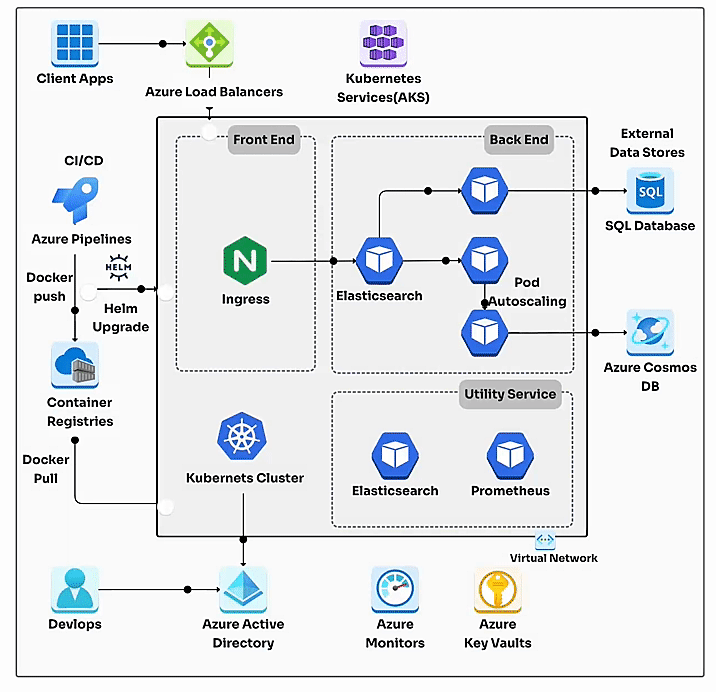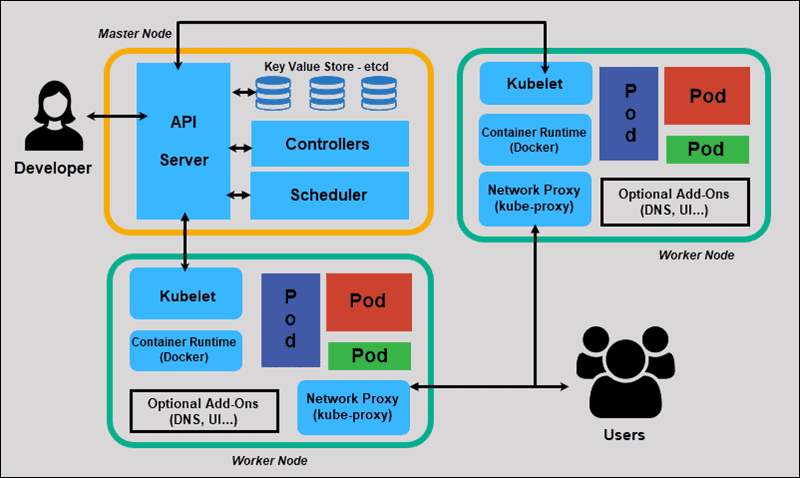
What is Kubernetes Architecture?
Kubernetes architecture refers to the structured design of the Kubernetes system, comprising various components that work cohesively to manage containerized applications across a cluster of machines. This architecture ensures high availability, scalability, and efficient resource utilization.
Core Components of Kubernetes Architecture
Control Plane
The control plane is the brain of the Kubernetes cluster, responsible for maintaining the desired state of the system. It comprises several key components:
API Server: Serves as the front-end, handling RESTful requests and updates to the cluster state.
etcd: A consistent and highly-available key-value store used as Kubernetes’ backing store for all cluster data.
Scheduler: Assigns workloads to nodes based on resource availability and other constraints.
Controller Manager: Runs controller processes to regulate the state of the system, such as node controllers and replication controllers.
Cloud Controller Manager: Integrates with the underlying cloud provider to manage cloud-specific control logic.
Data Plane
The data plane consists of the worker nodes that run the actual applications. Each node includes:
Kubelet: An agent that ensures containers are running in a Pod.
Kube-proxy: Maintains network rules on nodes, allowing network communication to Pods.
Container Runtime: Software responsible for running containers, such as Docker or containerd.
Kubernetes Cluster Architecture
A Kubernetes cluster is a set of nodes grouped together to run containerized applications. It consists of at least one master node (control plane) and multiple worker nodes (data plane). The master node manages the cluster, while worker nodes run the applications.
Kubernetes Architecture Diagram

Kubernetes Architecture Components Explained
Understanding each component’s role is vital:
API Server: Central management entity that receives REST commands and updates the cluster state.
etcd: Stores configuration data and cluster state information.
Scheduler: Assigns Pods to nodes based on resource availability.
Controller Manager: Ensures the cluster’s desired state matches the actual state.
Kubelet: Manages Pods and containers on a node.
Kube-proxy: Handles network routing for services.
Container Runtime: Executes containers as per the specifications.
Kubernetes Architecture for Beginners
For newcomers, grasping the Kubernetes architecture involves understanding how the control plane manages the cluster and how worker nodes execute applications. Beginners should focus on learning about Pods, Services, Deployments, and how these resources interact within the cluster.
Kubernetes Architecture on AWS
Amazon Elastic Kubernetes Service (EKS) provides a managed Kubernetes service on AWS. In EKS, AWS manages the control plane components, ensuring high availability and scalability. Users are responsible for managing worker nodes, which can run on EC2 instances or AWS Fargate.
Key features of Kubernetes architecture on AWS include:
Managed Control Plane: AWS handles the availability and scalability of the control plane.
Integration with AWS Services: Seamless integration with services like IAM, VPC, and CloudWatch.
High Availability: Control plane components are distributed across multiple Availability Zones.
Kubernetes Multi-Master Architecture
In a multi-master architecture, multiple master nodes run control plane components to ensure high availability and fault tolerance. This setup prevents a single point of failure, as the cluster can continue functioning even if one master node fails.
Implementing a multi-master architecture involves:
Load Balancing: Distributing traffic among multiple API servers.
etcd Clustering: Running etcd in a clustered mode across master nodes.
Certificate Management: Ensuring secure communication between components.
Conclusion
Understanding the Kubernetes architecture is fundamental for deploying and managing containerized applications efficiently. By comprehending the roles of the control plane and data plane, the interaction between components, and the deployment strategies on platforms like AWS, practitioners can harness the full potential of Kubernetes.
FAQs
Q1: What is Kubernetes architecture?
A: Kubernetes architecture is the structured design comprising the control plane and data plane components that manage and run containerized applications across a cluster.
Q2: How does the control plane differ from the data plane?
A: The control plane manages the cluster’s state and makes decisions about scheduling and responding to events, while the data plane consists of worker nodes that execute the actual workloads.
Q3: What are the main components of the control plane?
A: The control plane includes the API server, etcd, scheduler, controller manager, and cloud controller manager.
Q4: How does Kubernetes architecture integrate with AWS?
A: AWS offers Amazon EKS, a managed Kubernetes service where AWS manages the control plane, and users manage the worker nodes, integrating seamlessly with other AWS services.
Q5: What is a multi-master architecture in Kubernetes?
A: A multi-master architecture involves running multiple master nodes to ensure high availability and fault tolerance, preventing a single point of failure in the cluster.